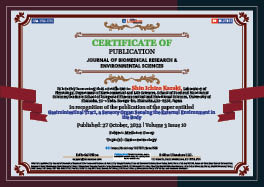Shin-Ichiro Karaki*
Volume3-Issue10
Dates: Received: 2022-10-18 | Accepted: 2022-10-25 | Published: 2022-10-27
Pages: 1269-1270
Abstract
Gastrointestinal (GI) tract seems to be the organ in the body; however, its lumen is external environment because opening to the external environment from mouth and anus. Moreover, it cannot be thought of the place where there are more than 1,000 species and 100-trillion numbers of microorganisms as an internal environment. Many multicellular animals including humans’ separates between internal environment and external environment by special tissues called epithelia. Barrier functions of epithelia prevent invading of luminal antigens, harmful substances, and microorganisms, etc, so that all the other cells excepting epithelial cells can leave from expose of them. However, on the ground of function of nutrient ingestion, the structure of the epithelium lining the lumen of the GI tract can strengthen not so much and consists of only one-layer of epithelial cells called simple columnar epithelium, different from the epidermis consisting of a strong barrier called stratified squamous epithelia. Therefore, the GI tract must have special host-defense functions making up for the weak barrier simultaneously to conduct the contradictory functions of nutrient ingestion and prevention from invasion of harmful substances and microorganisms.
FullText HTML
FullText PDF
DOI: 10.37871/jbres1588
Certificate of Publication

Copyright
© 2022 Karaki SI. Distributed under Creative Commons CC-BY 4.0
How to cite this article
Karaki SI. Gastrointestinal Tract, a Sensory Organ Sensing the External Environment in the Body. 2022 Oct 27; 3(10): 1269-1270. doi: 10.37871/jbres1588, Article ID: JBRES1588, Available at: https://www.jelsciences.com/articles/jbres1588.pdf
Subject area(s)
References
- Takahashi D, Kimura S, Hase K. Intestinal immunity: to be, or not to be, induced? That is the question. Int Immunol. 2021 Nov 25;33(12):755-759. doi: 10.1093/intimm/dxab051. PMID: 34375433.
- Shi N, Li N, Duan X, Niu H. Interaction between the gut microbiome and mucosal immune system. Mil Med Res. 2017 Apr 27;4:14. doi: 10.1186/s40779-017-0122-9. PMID: 28465831; PMCID: PMC5408367.
- Buck L, Axel R. A novel multigene family may encode odorant receptors: a molecular basis for odor recognition. Cell. 1991 Apr 5;65(1):175-87. doi: 10.1016/0092-8674(91)90418-x. PMID: 1840504.
- Hoon MA, Adler E, Lindemeier J, Battey JF, Ryba NJ, Zuker CS. Putative mammalian taste receptors: a class of taste-specific GPCRs with distinct topographic selectivity. Cell. 1999 Feb 19;96(4):541-51. doi: 10.1016/s0092-8674(00)80658-3. PMID: 10052456.
- Wu SV, Rozengurt N, Yang M, Young SH, Sinnett-Smith J, Rozengurt E. Expression of bitter taste receptors of the T2R family in the gastrointestinal tract and enteroendocrine STC-1 cells. Proc Natl Acad Sci U S A. 2002 Feb 19;99(4):2392-7. doi: 10.1073/pnas.042617699. PMID: 11854532; PMCID: PMC122375.
- Höfer D, Püschel B, Drenckhahn D. Taste receptor-like cells in the rat gut identified by expression of alpha-gustducin. Proc Natl Acad Sci U S A. 1996 Jun 25;93(13):6631-4. doi: 10.1073/pnas.93.13.6631. PMID: 8692869; PMCID: PMC39077.
- Kaji I, Karaki S, Fukami Y, Terasaki M, Kuwahara A. Secretory effects of a luminal bitter tastant and expressions of bitter taste receptors, T2Rs, in the human and rat large intestine. Am J Physiol Gastrointest Liver Physiol. 2009 May;296(5):G971-81. doi: 10.1152/ajpgi.90514.2008. Epub 2009 Jan 29. PMID: 19179623.
- Kaji I, Karaki S, Kuwahara A. Effects of luminal thymol on epithelial transport in human and rat colon. Am J Physiol Gastrointest Liver Physiol. 2011 Jun;300(6):G1132-43. doi: 10.1152/ajpgi.00503.2010. Epub 2011 Mar 3. PMID: 21372164.
- Bayliss WM, Starling EH. The mechanism of pancreatic secretion. J Physiol. 1902 Sep 12;28(5):325-53. doi: 10.1113/jphysiol.1902.sp000920. PMID: 16992627; PMCID: PMC1540572.






























































